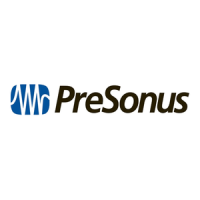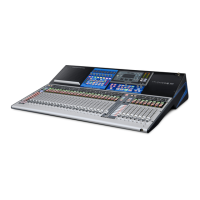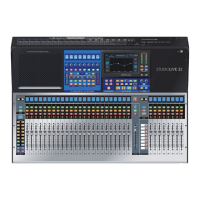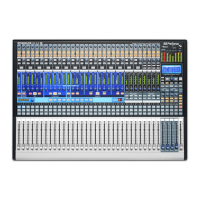Do you have a question about the PRESONUS studiolive III series and is the answer not in the manual?
Step-by-step guide to setting input levels for optimal signal and avoiding clipping.
Explains how Select buttons access Fat Channel parameters for channels and buses.
Details the integrated 34-track SD recorder for multi-track recording and Virtual Soundchecks.
Describes routing any analog or digital input to any channel and any mix to any output.
Details the rear panel connectivity for StudioLive 64S, 32S, 32SX, and 32SC models.
Explains analog inputs, outputs, and digital/networking connections on the rear panel.
Covers AES, AVB, Ethernet, and USB connections for digital audio and network control.
Explains the layout and controls of the StudioLive channel strip.
Step-by-step instructions on how to create new Filter DCA Groups.
Details the Talkback microphone input and routing options.
Explains the various applications and configurations for FlexMix buses.
Covers creating auxiliary mixes for monitors or external effects.
Instructions on creating custom monitor mixes for musicians.
Explains how subgroups combine channels for unified control and processing.
Step-by-step guide to creating a subgroup using FlexMix masters.
Details the dedicated mono bus on the StudioLive 64S for mono mixes or center channel.
Introduces the Fat Channel's powerful signal processing and mixing tools.
Explains the Noise Gate parameters and its function as an expander.
Explains the Compressor parameters and its three available models.
Explains the EQ settings and the three available EQ models.
Introduces StudioLive's internal effects processors with classic models.
Covers storing and recalling mixer settings using Projects and Scenes.
Guides on using the RTA to identify and eliminate feedback frequencies.
Explains how to check for and install firmware updates.
Covers audio routing options and the digital patching interface.
Offers compression presets for vocals, percussion, keyboards, and more.
Provides frequency guides for cutting and boosting EQ for various instruments.
Offers EQ presets for different instruments and vocal types.
Details various effects like Reverb, Delay, Chorus, and Flanger.
Provides information for troubleshooting common issues.
Step-by-step guide to setting input levels for optimal signal and avoiding clipping.
Explains how Select buttons access Fat Channel parameters for channels and buses.
Details the integrated 34-track SD recorder for multi-track recording and Virtual Soundchecks.
Describes routing any analog or digital input to any channel and any mix to any output.
Details the rear panel connectivity for StudioLive 64S, 32S, 32SX, and 32SC models.
Explains analog inputs, outputs, and digital/networking connections on the rear panel.
Covers AES, AVB, Ethernet, and USB connections for digital audio and network control.
Explains the layout and controls of the StudioLive channel strip.
Step-by-step instructions on how to create new Filter DCA Groups.
Details the Talkback microphone input and routing options.
Explains the various applications and configurations for FlexMix buses.
Covers creating auxiliary mixes for monitors or external effects.
Instructions on creating custom monitor mixes for musicians.
Explains how subgroups combine channels for unified control and processing.
Step-by-step guide to creating a subgroup using FlexMix masters.
Details the dedicated mono bus on the StudioLive 64S for mono mixes or center channel.
Introduces the Fat Channel's powerful signal processing and mixing tools.
Explains the Noise Gate parameters and its function as an expander.
Explains the Compressor parameters and its three available models.
Explains the EQ settings and the three available EQ models.
Introduces StudioLive's internal effects processors with classic models.
Covers storing and recalling mixer settings using Projects and Scenes.
Guides on using the RTA to identify and eliminate feedback frequencies.
Explains how to check for and install firmware updates.
Covers audio routing options and the digital patching interface.
Offers compression presets for vocals, percussion, keyboards, and more.
Provides frequency guides for cutting and boosting EQ for various instruments.
Offers EQ presets for different instruments and vocal types.
Details various effects like Reverb, Delay, Chorus, and Flanger.
Provides information for troubleshooting common issues.
| Built-in Effects | Yes |
|---|---|
| USB Interface | Yes |
| Network Control | Yes |
| AVB Networking | Yes |
| Preamp Type | XMAX |
| Bit Depth | 24-bit |
| Display | Touchscreen |
| Type | Digital |
| Channels | 16, 24, 32 |
| Recording | Yes |
| EQ Bands | 4-band |
| Effects | Reverb, Delay, Chorus, Flanger, etc. |
| Wireless Control | Yes |
| Sample Rate | 96kHz |
| Compatibility | Mac, Windows |
| Outputs | 16, 24, 32 |
| Inputs - Mic Preamps | 16, 24, 32 |











